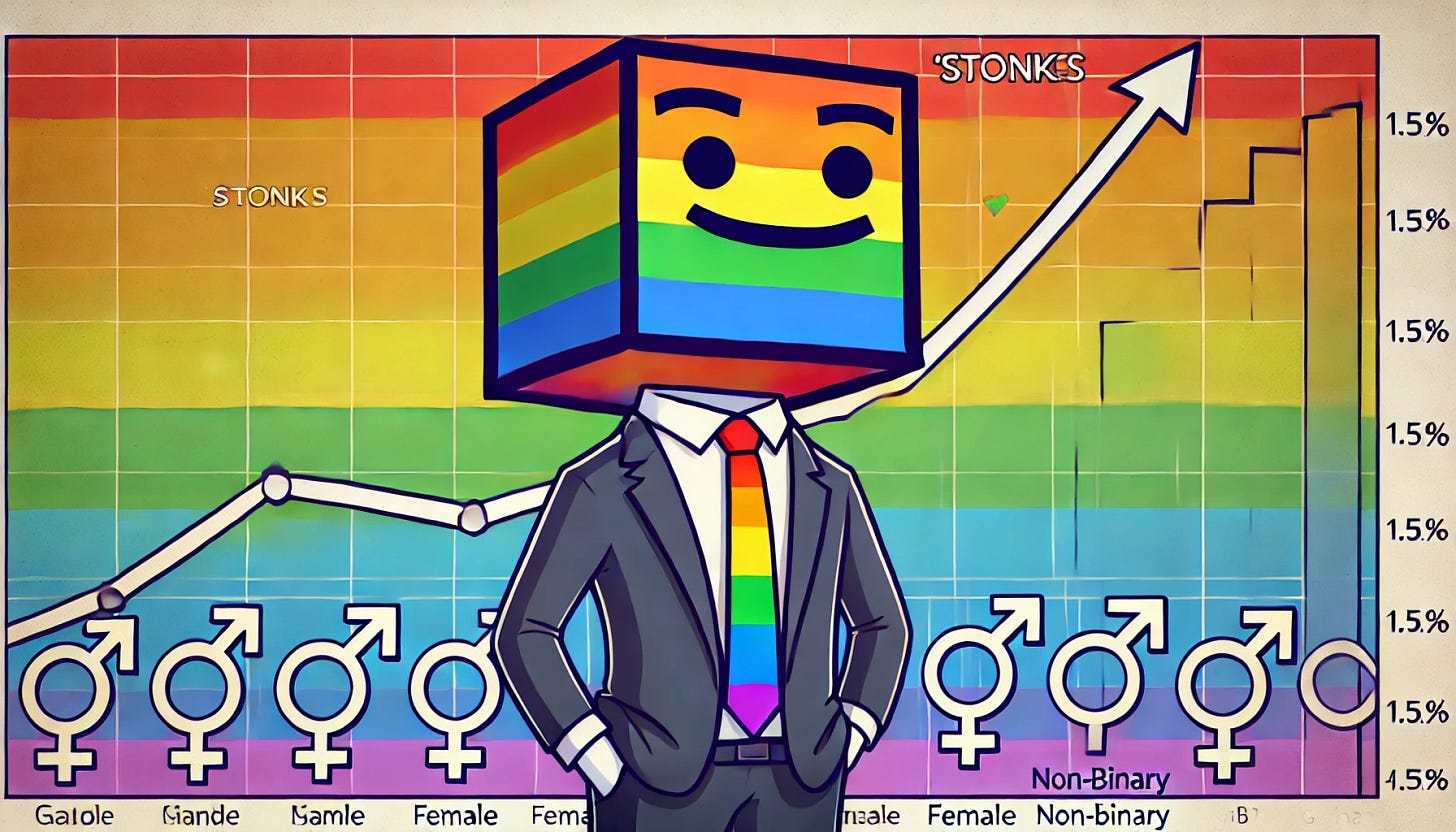The question explored in my last post rests on an assumption I hadn’t done my due diligence to verify. Are LGBTQ+ populations actually growing? Where, by what metrics, and by what scale? Here, I’ll break the question down into a few further forms, and lay out hypotheses for testing these questions.
DALL-E: “Draw the stonks meme with finance arrows going up but make it LBGTQ rainbow themed with gender symbols”
1. Absolute vs. Relative Population Increase?
I believe sexual orientation to be an innate biological phenomenon*. Born this way. If a certain proportion of any human population is gay, bisexual, or transgender, and if that percentage is stable, the queer population will vary with the overall population in absolute terms. For example, if 3% of the population is always queer, the total queer population would double from 120 million to 240 million as the global population doubled from 4 billion to 8 billion in the last 50 years. That is one form of growth, but it’s not what most people are getting at when they ask if people are becoming “gayer.” I’m expecting that any historical changes in queer population size will be mostly accounted for by overall population and demographic change, and that proportion changes will be much smaller*.
2. Countries in the Closet?
Most data on the subject is from the United States and other WEIRD (Western, Educated, Industrialized, Rich, and Democratic) populations. Homosexuality is now largely accepted in WEIRD countries, but not in much of the rest of the world. If people “became” more gay in the last 50 years of the West, did they really become more gay, or did they just finally feel safe enough to respond to the surveys accurately? I’m expecting that most of the “increase” in homosexuality in the last 50 years is explained by lifting a veil of stigma to reveal what was already there*. Conversely, this means that the global absolute queer population may actually be underestimated, because most of the recent world population growth has come from Africa, India, and China (China’s population more than doubled from 1950 to 2020, despite their plummeting birth rates). India, China, and all countries in Africa (except South Africa, which legalized same-sex marriage in 2006, nearly a decade ahead of the United States) still ban same-sex marriage. Despite making up more than half of the world’s population – and therefore half of the world’s gay population, if the biological base rate is truly the same – most gay people born in these countries, as well as in the Middle East, might remain in the closet and report inaccurate survey data (if sexual orientation is being surveyed at all).
3. LGB without the T(Q+)? Without the B?
*This is where the asterisks come in, and the jumping between language of “gay” and “queer”.
I believe that the evidence strongly supports innate sexual orientation and gender identity, and that the rates of homosexuality and gender dysphoria as innate biological phenomena are unlikely to change at a species level. Queerness is something different, and something new. As the LGB community grew to LGBT, to LGBTQ, to LGBTQIA2S+ (adding intersex, asexual, and “two-spirit” gender-fluid identities to the mix), no doubt it has grown, simply because the borders have gotten wider. Intersex and asexual people have always existed, and if they now fall under the umbrella of queer, that is a simple explanation for how the queer-identifying population may be growing. Humanity hasn’t changed, the labels have. I expect there to be little change in gay and lesbian identities, and transgender identities as the result of intersex conditions, all of which have clear biological causes. Queerness, however, may very well increase as a result of sociocultural changes. Its very definition is identity which does not conform to established gender and sexuality norms. Depending on one’s affinity for the label, that could include even slightly more effeminate men or slightly more androgynous women. Bisexuality falls into a unique middleground. My expectation is that though the underlying distribution of sexual attraction is unlikely to change biologically, our labels for it might. Someone who is able to appreciate the beauty of a same-sex or transgender person, while otherwise identifying as straight in any other historical context, might now consider that enough to make them pansexual or queer. My sense is that less about our underlying sexuality is changing than is our use of labels. Labels are exclusive, even discriminatory. A young person navigating their identity might not want such strict boundaries. What does one have to lose by identifying as queer? Isn’t everyone queer – different – in their own unique way?




